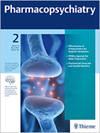难治性抑郁症患者群体的风险表型、并发症、药物治疗和电休克疗法 (ECT) 与未用药对照组的比较
IF 2.2
3区 医学
Q2 PHARMACOLOGY & PHARMACY
引用次数: 0
摘要
背景 大约 15-25% 的抑郁症患者患有难以治疗的抑郁症 (DTD)。难治性抑郁症患者需要接受全面检查,以避免忽略可治疗的(精神/症状)并发症或对抗抑郁药物(ADs)的(假)耐药性。细胞色素 P450(CYP)酶 2D6 和 2C19 的多态性在抗抑郁药物的代谢中起着重要作用,可能会导致对抗抑郁药物的耐药性。DTD患者可能会从电休克疗法(ECT)中获益。方法 我们招募了 109 名 DTD 患者和 29 名未经治疗的抑郁症对照组 (UDC)。我们对风险表型、合并症和治疗(包括 ECT)进行了评估。我们还对 CYP2D6 和 CYP2C19 进行了药代动力学分析。结果 与 UDC 患者相比,DTD 患者更常合并精神疾病,尤其是 ICD-10:F40-F48(DTD:40.4%,UDC:17.2%,OR 11.87,P=0.011)。接受电痉挛疗法的 DTD 患者更有可能获得缓解(37.7% 对 11.8%,OR=3.96,P=0.023)。缓解者和非缓解者在使用反兴奋剂治疗方面没有差异。两组患者的 CYP2D6 和 CYP2C19 变体分布无明显差异。结论 DTD 患者似乎更经常合并神经紧张和躯体形式障碍(ICD-10:F40 - F48)。因此,当患者对抗抑郁药物反应不佳时,全面的鉴别诊断至关重要。应考虑对 CYP2D6 和 CYP2C19 进行基因分型。本文章由计算机程序翻译,如有差异,请以英文原文为准。
Risk Phenotypes, Comorbidities, Pharmacotherapy, and Electroconvulsive Therapy (ECT) in a Cohort with Difficult-to-Treat Depression in Comparison to an Unmedicated Control Group
Background Approximately 15–25% of depressed patients suffer from difficult-to-treat depression (DTD). Patients with DTD require a thorough examination to avoid the oversight of treatable (psychiatric/somatic) comorbidities or (pseudo-)resistance to antidepressant drugs (ADs). Polymorphisms of the cytochrome P450 (CYP) enzymes 2D6 and 2C19, which play a major role in the metabolism of ADs, may contribute to resistance to ADs. Patients with DTD might benefit from electroconvulsive therapy (ECT). Methods We enrolled 109 patients with DTD and 29 untreated depressed controls (UDC). We assessed risk phenotypes, comorbidities, and treatment, including ECT. We also performed pharmacokinetic analyses of CYP2D6 and CYP2C19. Results DTD patients significantly more often suffered from comorbid psychiatric diseases, especially ICD-10: F40-F48 (DTD:40.4%, UDC:17.2%, OR 11.87, p=0.011) than UDC patients. DTD patients receiving ECT were more likely to achieve remission (37.7% vs. 11.8%, OR=3.96, p=0.023). Treatment with ADs did not differ between remitters and non-remitters. No significant differences were observed in the distribution of CYP2D6 and CYP2C19 variants between both groups. Conclusion Patients with DTD appear to experience comorbid neurotic stress and somatoform disorders (ICD-10: F40 – F48) more frequently. Therefore, a comprehensive differential diagnosis is crucial when patients do not respond sufficiently to antidepressant medication. Genotyping CYP2D6 and CYP2C19 should be considered.
求助全文
通过发布文献求助,成功后即可免费获取论文全文。
去求助
来源期刊

Pharmacopsychiatry
医学-精神病学
CiteScore
7.10
自引率
9.30%
发文量
54
审稿时长
6-12 weeks
期刊介绍:
Covering advances in the fi eld of psychotropic drugs, Pharmaco psychiatry provides psychiatrists, neuroscientists and clinicians with key clinical insights and describes new avenues of research and treatment. The pharmacological and neurobiological bases of psychiatric disorders are discussed by presenting clinical and experimental research.
 求助内容:
求助内容: 应助结果提醒方式:
应助结果提醒方式:


